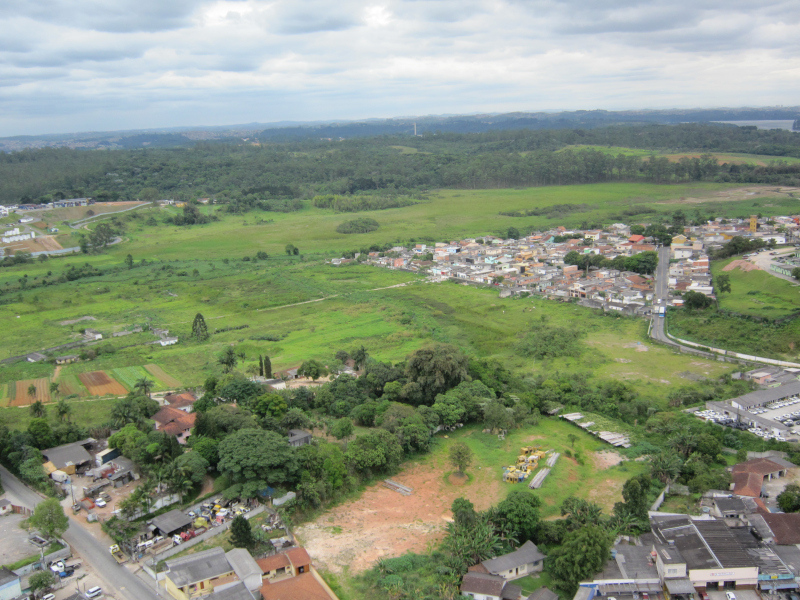

Aerial view of the Parelheiros region in the municipality of São Paulo. Urban fringes have multiple uses, including housing, forests, pastures, and food cultivation (photo: Luciana Schwandner Ferreira/BIOTA Synthesis)
Researchers from a FAPESP-supported research center point to 410,000 hectares of land in cities that could be regenerated.
Researchers from a FAPESP-supported research center point to 410,000 hectares of land in cities that could be regenerated.

Aerial view of the Parelheiros region in the municipality of São Paulo. Urban fringes have multiple uses, including housing, forests, pastures, and food cultivation (photo: Luciana Schwandner Ferreira/BIOTA Synthesis)
Agência FAPESP* – A study conducted at the University of São Paulo (USP) by researchers from the Nucleus of Analysis and Synthesis of Nature-Based Solutions (BIOTA Synthesis), a FAPESP Science Center for Development (SCD), identified approximately 410,000 hectares in the state of São Paulo, Brazil, with potential for forest restoration in urban fringe areas.
These peripheral areas of urban centers are characterized by diverse land uses, such as residential neighborhoods, agricultural land, recreational spaces, urban infrastructure, and aquatic zones. They are not normally included in surveys of potential restoration areas. The findings of the study are equivalent to nearly one-third of the state’s goal of restoring 1.5 million hectares by 2050.
The results of the study were published in the journal Scientific Reports.
“These are interesting areas because they’re close to cities and people, which maximizes the benefits of restoration. We saw that regeneration has exceeded deforestation since 2005, despite urban pressure,” Luciana Schwandner Ferreira explains to Agência FAPESP. She is a researcher at the Institute of Advanced Studies (IEA) at USP and the lead author of the study, which was funded by a scholarship from FAPESP.
The research analyzed three decades (1990-2020) of deforestation and regeneration data collected by the MapBiomas project across the state of São Paulo. MapBiomas is a collaborative network formed by non-governmental organizations, universities, and technology startups that maps land cover and land use in Brazil. For the first time, the research distinguished between dense urban areas, urban fringes, and rural areas. The results show that forest transition has already occurred in all regions studied. Urban fringes show the highest rates of regeneration, albeit with limited support from public policies.
“Even without specific policies, urban fringes already show significant regeneration rates, indicating significant potential for forest restoration. This process could be stimulated and expanded through public policies focused on these areas, bringing restoration closer to the 96% of the state’s population that currently lives in cities,” says Jean Paul Metzger, a professor at the Institute of Biosciences (IB) at USP and coordinator of BIOTA Synthesis, who led the study.
The São Paulo macrometropolis, a region comprising 174 municipalities, is an interesting case for considering restoration on urban fringes. Its proximity to well-preserved areas, such as the Serra do Mar State Park and other conservation units, may facilitate natural regeneration and reduce costs. In cases where active planting is necessary, proximity to the most populous area of the state facilitates access to labor and job creation.
According to the researchers, restoration projects are easier to implement in areas where the opportunity cost of land is low – that is, where the land’s value and potential gains from other uses are low. However, the environmental and social benefits are amplified when these projects are carried out near cities.
In addition to promoting biodiversity and protecting the environment, restoring urban and peri-urban areas can contribute to human health and well-being, regulate the climate, mitigate extreme events, improve water and air quality, and provide recreational spaces.
Numbers
The 410,000 hectares with restoration potential are equivalent to 51% of the total area of these regions. Of these, 235,000 hectares are located in the São Paulo macrometropolis, directly benefiting 32.7 million people.
Thirty-nine thousand hectares of the total potential areas are in regions that are both at risk and subject to permanent preservation (APP), such as riverbanks and hilltops. These areas require urgent restoration under the Brazilian Forest Code (Law No. 12,651/2012).
“More detailed studies on ecological and socioeconomic suitability still need to be carried out to guide which strategies are most appropriate in each case,” says Ferreira.
The study acknowledges that urban fringes are highly contested territories, often earmarked for urban expansion or agriculture, particularly small-scale family farming. Therefore, restoration efforts will need to coexist with other uses. The researchers take into account the need to mitigate social risks, such as the displacement of vulnerable populations or gentrification processes associated with environmental improvement.
The authors also emphasize that urban fringes have many different actors and socio-environmental characteristics. This requires the types of restoration to be defined in a contextualized manner. In some cases, natural regeneration and ecological restoration are prioritized. In others, it is productive models that integrate the cultivation of native species for food and wood. In certain contexts, the focus is on objectives related to urban green infrastructure.
The work was also supported by FAPESP through the project “Resilience and adaptation to climate change in cities: time to act with nature-based solutions” and postdoctoral fellowships (22/07415-0 and 22/09161-6).
The article “Urban boundaries are an underexplored frontier for ecological restoration” is available at nature.com/articles/s41598-025-19699-9.
* With information from BIOTA Synthesis
Republish
The Agency FAPESP licenses news via Creative Commons (CC-BY-NC-ND) so that they can be republished free of charge and in a simple way by other digital or printed vehicles. Agência FAPESP must be credited as the source of the content being republished and the name of the reporter (if any) must be attributed. Using the HMTL button below allows compliance with these rules, detailed in Digital Republishing Policy FAPESP.





